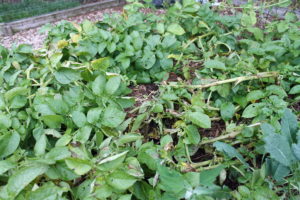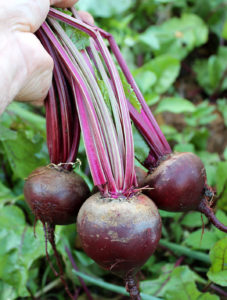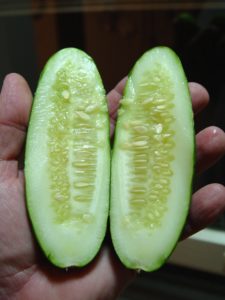When to Harvest Those Vegetables
July 6th, 2016
You’ve planted, watered, protected from animals, sidestepped assorted bugs, diseases and “weather events,” and now your vegetables are just about ready for the kitchen.

Theses potatoes are flopping and starting to yellow — signs that “new” potatoes are ready and full harvest is nearing.
But how do you when to make your picking move?
Vegetables are at their tastiest and most nutritious when they’re picked at the peak of ripeness, but that’s not always obvious.
Sometimes a day or two can make a big difference. Pick a little too soon, and the flavor isn’t as sweet or as good as it could be. Pick too late, and the texture may be getting mushy or woody or the flavor bitter.
One of the tricks of veggie gardening is learning the cues that tell you when is the right time to make your move.
Here’s a harvest tip list for 25 of the most common home-garden crops:
Asparagus. Make several cuttings in spring, removing shoots to just below the soil line with a sharp knife when the shoots reach 6 to 8 inches tall. Cut before the foliage starts to open. Stop cutting by late spring to allow plants to recharge themselves over summer.
Beans. Pick when fully elongated but before the bean seeds inside start to bulge. Keep picking… they mature fast and get stringy within days if you delay.
Beets. Pull any time they’re 1 inch or larger. Young ones are most tender. Ones over 3 inches start to get woody. Leaves are edible, too.

Don’t let beets get too big or they’ll start to get “woody.”
Broccoli. Watch for the heads to reach full size and cut them at the first sign that the florets are losing their tightness or starting to show yellow. That’s the point where the plant is progressing into flowering. Most varieties will produce smaller side shoots that can be harvested for weeks more after the main head is cut.
Cabbage. Heads can be cut any time from when they start forming baby heads up to the point where they begin to split – a sign you’ve waited a bit too long.
Carrots. Harvest gradually, starting with baby ones early. Gauge size by pulling back a little soil to see how wide the shoulders are. Sample one to be sure. Harvest all before any hint of bitterness from summer heat.
Cauliflower. Cut heads any time from when they’re small up to full size… but before the florets start to open.
Collards/kale. Start cutting leaves from around the perimeter any time they’re big enough to use. Harvest continually, taking the older outer leaves while leaving behind the younger inner leaves for the next harvest.
Corn. Do the finger-nail test. Open the top of the husk and puncture a few kernels. Ripe ones will pop and spray a milky fluid. The silks will be dry, too – typically about 3 weeks after they formed. Ears will feel tight and plump.

Cucumber seeds are smaller and much more tender when you pick fruits before full size.
Cucumbers. Pick when green and slender. If they start to fatten and take on a yellow or creamy color, they’ll be seedy and turning bitter. Err on the young side, and pick regularly because they mature quickly.
Eggplant. Also err on the young side. Cut or twist from the plant when fruits are firm and shiny. They’re heading downhill when the skin dulls. Like cukes, overripe fruits get bitter.
Garlic/shallots. Dig or pull when foliage has browned and flopped over. Dry well before storing.
Leeks. Pull any time from finger-sized on up. Just get them out before they start splitting.
Lettuce. Depends on type. Leaf lettuce can be harvested continually, starting when the leaves are big enough and continuing until flower stalks appear (which makes the taste bitter). Harvest the older, outer leaves. Romaine and head types should be allowed to grow to nearly full size before being cut off at the base. You’ll know you’ve waited too long if flower stalks appear or the heads begin to split apart.
Muskmelon (cantaloupe). Rind color will turn a light brown, and netting on fruits will become more pronounced. The sniff test is best. You should be able to detect that sweet melon smell where the vine attaches. Fruits also slip easily off the vine when ripe.
Okra. Twist off or cut off pods when they’re young and tender. Wait too long and pods get tough and woody. Harvest continually as new pods keep maturing.
Onions. “Spring onions” can be pulled any time in spring if you’re using just the leaves instead of waiting for bulbs to form. Mature onions are ready when the leaves fall over and turn brown.
Peas. Depends on the type. Pick edible-podded peas when they’re young, tender and before the seeds inside swell. For English or shelling peas, let the pods mature until they’re plump and the seeds inside are noticeable. Pick before they turn brown or begin to split open.

Green peppers aren’t yet mature. Wait if you want them to turn red, gold, orange or whatever they’re ripe color is.
Peppers. The sweetest and most nutritious stage is when the fruits turn red, gold or orange. They’re perfectly usable when firm and green, but like tomatoes, they’re not actually ripe then.
Potatoes. Poke around for young “new” potatoes when plants flower. Dig full-size ones when plants brown and flop.
Spinach. Start snipping any time they’re big enough to use. Continue cutting from the around the outside, letting new inner leaves to grow a few more days until the next cutting. Yank plants when flower stalks appear. The taste becomes bitter at that point.
Rhubarb. Twist off or cut off stalks for several weeks in spring, just as each leaf stops increasing in size. Younger stalks also can be harvested. Stop harvesting in late spring to allow the plant to recharge itself over summer.
Tomatoes. Twist off when fruits are still firm but fully colored (although some types retain green shoulders even at full ripeness). Get them before they turn soft and begin to rot.
Watermelon. Fruit undersides will turn a creamy/yellowish color. Do the thump test: ripe fruit makes a hollow sound. The tendrils on the vines (skinny little pigtail-like growths) will go from green to brown.
Zucchini/squash. Twist off when small and young – about the size of a mid-sized cucumber. These can get seedy and bitter if you let them grow to baseball-bat size (which can happen in a few days).







